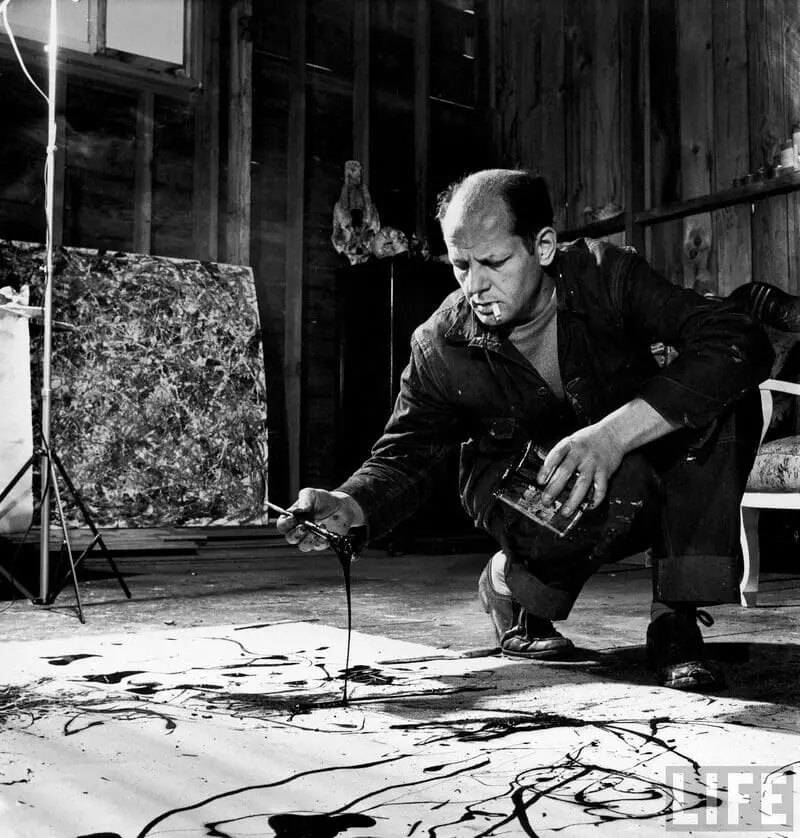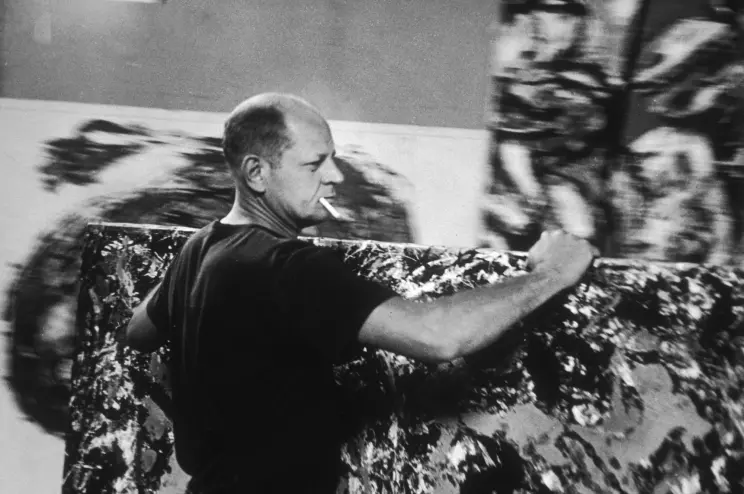If you watched the 2016 movie The Accountant, one thing that will stand out to you is all the famous paintings in the movie. In particular, the film shows one of Jackson Pollock’s paintings, Free Form (1946).
We do not know precisely how much the Jackson Pollock Free Form painting is worth, but we know that it is owned by the Museum of Modern Art in New York City, and the painting in the movie The Accountant is a reproduction or copy. Similar Jackson Pollock paintings have sold for over $100 million. So, we know that Jackson Pollock’s paintings are valuable in today’s art market.
Table of Contents
- The Accountant Movie (2016) And Jackson Pollock
- Possible Value Of The Jackson Pollock Free Form (1946)
- About Free Form (1946) Jackson Pollock
- Jackson Pollock’s Abstract Expressionism Action Painting
- Jackson Pollock: The Maverick of Modern Art – 10 Facts About Jackson Pollock
- 9 Fascinating Facts About Jackson Pollock
- Frequently Asked Questions
- Related Questions
The Accountant Movie (2016) And Jackson Pollock
The Accountant Movie (2016) stars Ben Affleck as Christain Wolff, an accountant who was diagnosed with autism. This movie shows several famous paintings, including the Free Form (1946) artwork by Jackson Pollock.

At the movie’s end, the Accountant (Christian Wolf) plays a central role in the Jackson Pollock painting. The painting shown in the film is not an original Jackson Pollock painting but a reproduced copy of his Free Form 1946.
Possible Value Of The Jackson Pollock Free Form (1946)

The painting in the movie The Accountant is a Jackson Pollock painting called the Free Form (1946). The Free Form is typical of many of Jackson Pollock’s other types of paintings and styles.
Here are a few facts about the painting and what it could be worth:
- Free Form (1946) – MoMA in New York owns the Free Form 1946. It is not owned by the movie The Accountant.
- Free Form In The Accountant Is A Copy – The Free Form (1946) in the movie The Accountant is a copy and not the original, so it does not have a lot of value as it is a copy.
- David Geffen Sold A Pollock Painting For 140 Million – The Hollywood Entertainment magnate David Geffen sold a Jackson Pollock painting in 2016 called No 5 (1948) for $140 million.
This is not the same painting as the Free Form (1946), but it can give us an idea of how much an original Jackson Pollock painting can be worth. The painting was a private sale, so the prices of the painting or the sale have not been confirmed. But it shows how valuable many Jackson Pollock paintings are in today’s market. - Value Is Due To Provenance – The David Geffen painting has sold for so much because the Jackson Pollock painting has what is known as pristine provenance. Many Jackson Pollock copies are hard to verify if they are real or copies of Jackson Pollock’s artwork.
- Jackson Pollock’s ArtWork Is Now Valuable – Jackson Pollock’s artwork is now considered very valuable. He is considered one of the founders of the abstract expressionism movement and a creator of action painting.
His work is original and creative. He also inspired many other artists and art movements after him. This even though he did not see much success in his lifetime. He rarely could sell a painting for over US$10,000 and struggled quite a bit with money and finances, yet today, his paintings are going for millions of dollars.

Listen To Our Podcast About The Mystery Behind The Jackson Pollock Painting In “The Accountant by clicking here.
About Free Form (1946) Jackson Pollock
It is thought that Jackson Pollock’s Free Form painting was one of his first drip-style paintings. He began by painting the entire canvas red, adding black and white tangles, and pulling up paint.
Pollock painted this using his action painting technique by flinging and dripping diluted oil paint with a brush and stick. This painting is not very large as it is 19 1/4 inches by 14” (48.9 cm x 35.5 cm).
Even though the Museum of Modern Art (MoMA) owns the painting, it is not always on display at the museum.

Jackson Pollock’s Abstract Expressionism Action Painting
Jackson Pollock is one of the founders of the art movement known as abstract expressionism. He also was a creator of what is known as action painting.
The Free Form painting by Jackson Pollock is an excellent example of action painting. Action painting is when the painters work spontaneously and use large brushes to make sweeping gestural marks.
Jackson Pollock was known to place his canvas on the ground and to dance around the canvas while pouring paint from the can or trailing the canvas from behind with a brush or stick. This is why action painting is known to place the inner impulses of the artist onto the canvas itself.
Jackson Pollock is said to have placed his inner emotions onto the canvas he painted, many of them his inner demons.
In the movie The Accountant, the Jackson Pollock painting would have also represented some of the inner demons that the Accountant (Christian Wolff) had and why the painting was such a powerful representation of the film metaphor.

Jackson Pollock: The Maverick of Modern Art – 10 Facts About Jackson Pollock
Often hailed as the quintessential figure in the Abstract Expressionist movement, Jackson Pollock has left an indelible mark on the art world. His revolutionary painting approach and commitment to his unique vision have garnered him acclaim, analysis, and admiration.
Here are ten reasons why Jackson Pollock is considered among the greats:
Pioneering Drip Technique:
Pollock famously moved away from traditional painting methods to introduce his signature drip or “action painting” technique, allowing the paint to drip from the brush or can onto the canvas below.
Emotional Intensity:
His works capture raw emotion and are often viewed as a physical manifestation of his inner feelings, offering a profound depth that draws viewers in.
Breaking Convention:
Pollock stepped away from the easel, placing his canvases on the ground. This act defied tradition and enabled him to approach his work from all angles, creating a 360-degree interaction with his piece.
Scale and Immersion:
Many of Pollock’s pieces are vast, commanding an entire room and fully immersing viewers in the art, creating an environment rather than just a visual.
Innovative Materials:
Beyond traditional paints, Pollock often employed the use of commercial-grade enamels, aluminum paint, and even objects like sand or glass, broadening the texture and appeal of his pieces.
Pushing Boundaries:
In an era where representational art dominated, Pollock’s completely abstract pieces challenged and expanded the boundaries of what was considered art.
Influencing Future Artists:
His unique style and fearless commitment to his vision paved the way for subsequent art movements and inspired countless artists to explore abstract expressionism and other forms.
Capturing Movement:
Pollock’s action paintings froze the act of creation on canvas, allowing viewers to trace his movements and feel the rhythm and energy with which he created each piece.
Personal Complexity:
Pollock’s tumultuous personal life, struggles with alcoholism, and tragic early death added layers of intrigue and analysis to his work, making him a figure of fascination and study.
Cultural Impact:
Beyond the art community, Pollock became a cultural phenomenon. His life and works have been dissected in literature, film, and academic circles, making him a household name even among those unfamiliar with the nuances of the art world.
While Pollock remains a polarizing figure, with his work alternately celebrated and critiqued, his profound impact on modern art is undeniable.
His fearless dedication to expression and innovation solidifies his status as a great artist whose influence will continue to resonate for generations.
9 Fascinating Facts About Jackson Pollock
Jackson Pollock, often hailed as a pioneering figure in the world of abstract expressionism, has left an indelible mark on the art world with his signature “drip paintings.”
Though his masterpieces are recognized globally, there’s always more to discover about the artist. Let’s delve into ten fascinating facts about this remarkable individual:
Early Life in Wyoming:
Born in Cody, Wyoming, in 1912, Jackson Pollock grew up in a series of cities across the American West. These vast landscapes would later influence the sprawling canvases he became famous for.
The “Drip Technique”:
Pollock’s most famous paintings were created using a unique method where he would drip or pour paint onto canvas from above. This method, while revolutionary, was also highly controversial among critics of the time.
Influence of Native American Sand Painting:
Pollock was deeply inspired by Native American sand painting and Mexican muralists, which had elements of laying down materials in a freeform and abstract manner.
A Spotlight from Life Magazine:
In 1949, Life Magazine asked, “Is he the greatest living painter in the United States?” This brought significant public attention to Pollock and his unconventional techniques.
The Deep Impact of Psychoanalysis:
Pollock underwent psychoanalysis, which deeply impacted his work. His paintings often delved into his unconscious mind, with critics and scholars seeing them as a direct representation of his psyche.
The “Pollock-Krasner House”:
Pollock lived with his wife, fellow artist Lee Krasner, in a house in East Hampton, New York. Today, it’s a historic site and study center open to the public, preserving their legacy and providing insights into their creative lives.
Tragic End:
Pollock’s life was cut short in 1956 at the age of 44 due to a car crash. While his career was relatively short-lived, his influence on the art world reverberates.
Struggles with Alcohol:
Throughout his life, Pollock battled alcoholism, which often influenced his moods, relationships, and even his work. Some critics believe that the raw emotion in his pieces can be attributed to this ongoing struggle.
Legacy in Popular Culture:
Jackson Pollock’s life and work have been showcased in various media, with the most notable being the 2000 film “Pollock,” where actor Ed Harris portrayed the iconic artist and also directed the movie.
Jackson Pollock remains a pivotal figure in the 20th-century art scene, with his revolutionary techniques and tumultuous personal life providing ample material for discussion and appreciation.
While these ten facts offer a glimpse into his world, the depth and breadth of his influence stretch far beyond.
Anita Louise Art is dedicated to art education, great artists, and inspiring others to find and create their art. We love art that uplifts and inspires. #ArtToMakeYouSmile! #ArtToMakeYouHappy!
If you are interested in seeing any of my art, you can find out more by clicking here. If you are interested in what inspires me and my paintings, you can discover more by clicking here.
We have a free newsletter and would love you to be part of our community; you can subscribe to the newsletter by clicking here. I would be happy to talk to you if you have any questions. You can reach me, Anita, by clicking here.
Subscribe to our Anita Louise Art YouTube Channel with great videos and information by clicking here.
Join us for our podcast “5 Minutes With Art.” Spend just 5 minutes a week with us to discover and learn about great art and artists. You can find out more about our podcast by clicking here.
Frequently Asked Questions
Who was Jackson Pollock?
Jackson Pollock was an American painter who is widely regarded as one of the most influential artists of the 20th century.
What kind of art did Jackson Pollock create?
Jackson Pollock is best known for his abstract expressionist paintings, which often featured complex layers of dripped and splattered paint.
What is the value of a Jackson Pollock painting?
The value of a Jackson Pollock painting can vary widely depending on a number of factors, including the size and condition of the piece, the subject matter, and the level of interest from buyers. Some of his paintings have sold for tens of millions of dollars.
What is the significance of Jackson Pollock’s drip technique?
Jackson Pollock’s drip technique was a groundbreaking innovation in abstract expressionist art, as it allowed him to create complex, layered compositions full of movement and energy.
What inspired Jackson Pollock’s drip technique?
His interest inspired Jackson Pollock’s drip technique in Native American sand painting, as well as his desire to create a more spontaneous and intuitive form of art.
What was the reaction to Jackson Pollock’s work when it was first exhibited?
When Jackson Pollock’s work was first exhibited, it was met with a mixture of confusion and awe. Some critics dismissed it as chaotic and meaningless, while others recognized its groundbreaking nature and potential to change modern art.
How can I tell if a Jackson Pollock painting is authentic?
Authenticating a Jackson Pollock painting can be a complex and challenging process, as many forgeries and copies are in circulation. Experts look for a number of factors, including the style, materials, and provenance of the painting, to determine its authenticity.
Can I buy a Jackson Pollock painting?
Yes, buying a Jackson Pollock painting is possible, although they are extremely rare and expensive. Private collectors own some of his works, while others are held in museums and galleries around the world.
What is action painting?
Action painting is a technique associated with Jackson Pollock in which the artist applies paint to a canvas by dripping, pouring, or flinging it onto the surface. This spontaneous and energetic approach emphasizes the physical act of painting and the gestures of the artist.
Why is Jackson Pollock’s artwork valuable?
Jackson Pollock’s artwork is considered valuable due to its historical significance, artistic innovation, and influence on subsequent artists and art movements. His unique style and contribution to abstract expressionism have made his paintings highly sought after by collectors and art enthusiasts.
How did Jackson Pollock influence other artists and art movements?
Jackson Pollock’s innovative painting techniques and abstract expressionist style inspired many artists who came after him. His emphasis on the process of creating art, rather than the final product, influenced the development of various art movements, including the Color Field painting and the action painting movement.
Why didn’t Jackson Pollock achieve much success in his lifetime?
Despite his significant contributions to the art world, Jackson Pollock struggled to gain recognition and financial success during his lifetime. His unconventional style and departure from traditional artistic norms made it difficult for his work to find widespread acceptance in the art market of his time.
How much did Jackson Pollock’s paintings sell for during his lifetime?
Jackson Pollock faced financial difficulties during his lifetime and struggled to sell his paintings for substantial amounts. He rarely sold a painting for over US$10,000, and he often faced challenges in finding buyers for his artworks.
Why are Jackson Pollock’s paintings now selling for millions of dollars?
The value of Jackson Pollock’s paintings has increased significantly over time due to a combination of factors. As his artistic significance became recognized, his limited body of work became highly sought after. Additionally, the scarcity of his original paintings and their historical and artistic importance have contributed to their high market value.
Related Questions
Did They Use An Original Jackson Pollock Painting In Ex Machina Or A Replica?
They would have used a copy of painting No 5 (1948) as the painting was sold by David Geffen, a Hollywood producer and film studio executive, for over $140 million USD in 2006. Geffen would have sold the painting long before the movie was produced, and no respectable art collector would place such a valuable work of art on a film set or studio.
By clicking here, you can learn more by reading Did They Use An Original Jackson Pollock Painting In Ex Machina Or A Replica?.
What Makes Jackson Pollock’s Art So Valuable?
Jackson Pollock was a brilliant and creative artist who was not afraid to try new techniques with art. He is known for being a founder of Abstract Expressionism and the gestural technique, also known as action painting. He never saw much success in his lifetime, but today his paintings fetch millions of dollars and are considered extremely valuable.
By clicking here, you can discover more by reading What Makes Jackson Pollock’s Art So Valuable?.
Understanding Jackson Pollock’s Paintings And His Art
Understanding that Jackson Pollock has absolute honesty in his paintings, he shows us his great technique and ability to use paint in ways that have never been used before. His paintings are very dimensional, so when you look at them in one way but get up close, you may see another way. He’s not trying to fool us in any way but just saying here, view it as you want to see it.
By clicking here, you can learn more by reading Understanding Jackson Pollock’s Paintings And His Art.

